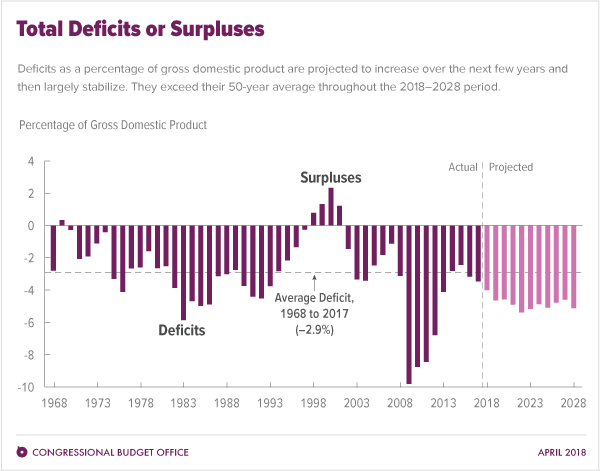Last Monday, the Congressional Budget Office released The Budget and Economic Outlook: 2018 to 2028, the latest installment of an annual report explaining the agency’s budget and economic projections. This week, CBO is publishing daily blog posts to share key excerpts from the report, and today’s post is about the agency’s projections of federal deficits and debt. (CBO has also posted a series of slides about those projections.)
Federal budget deficits are set to increase rapidly this year and over the next four years, CBO projects, and then to remain largely stable relative to the size of the economy—but at a very high level by historical standards—over the rest of the projection period. Those deficits would result in rising federal debt. Moreover, CBO’s baseline projections reflect a number of significant changes to tax and spending policies that are scheduled to take effect under current law. If those changes did not occur, deficits and debt would be substantially larger.
Rising Deficits
As required by statute, when constructing its baseline projections, CBO incorporates the assumption that current laws governing taxes and spending will generally remain unchanged in future years. Under that assumption, in CBO’s baseline, federal deficits average $1.2 trillion per year and total $12.4 trillion over the 2019–2028 period. As a percentage of gross domestic product (GDP), the deficit increases from 3.5 percent in 2017 to 5.4 percent in 2022. Thereafter, the deficit fluctuates between 4.6 percent and 5.2 percent of GDP from 2023 through 2028. Over the past 50 years, the annual deficit has averaged 2.9 percent of GDP.
That pattern of deficits is expected to occur mainly because, under current law, revenues and outlays would grow at different rates. Revenues would be roughly flat as a percentage of GDP over the next several years before rising steadily in the second half of the period. In contrast, outlays would increase in most years through 2028.
Growing Debt
The large deficits over the next 10 years would cause debt held by the public to rise steadily. Relative to the nation’s output, debt held by the public is projected to increase from 76.5 percent of GDP in 2017 to 96.2 percent at the end of 2028. At that point, federal debt would be higher as a percentage of GDP than at any point since just after World War II—and heading still higher.
Outcomes If Certain Changes Scheduled in Law Did Not Occur
In CBO’s baseline projections, deficits in the latter half of the decade, though quite large, are not trending upward relative to the size of the economy. That pattern occurs in large part because CBO’s projections reflect the assumption that substantial tax increases and spending cuts will take place as scheduled under current law.
If those changes did not occur and current policies were continued instead, much larger deficits and much greater debt would result: The deficit would grow to 7.1 percent of GDP by 2028 and would average 6.3 percent of GDP from 2023 to 2028, CBO estimates, compared with 4.9 percent in the baseline. With cumulative deficits of $15.0 trillion over the projection period, debt held by the public under that alternative fiscal scenario would reach 105 percent of GDP by the end of 2028, an amount that has been exceeded only one time in the nation’s history. Moreover, the pressures that are projected to contribute to that rise would accelerate and drive up debt even more in subsequent decades.
Barry Blom is an analyst in CBO’s Budget Analysis Division. The budget projections were the work of about 100 people at CBO.


